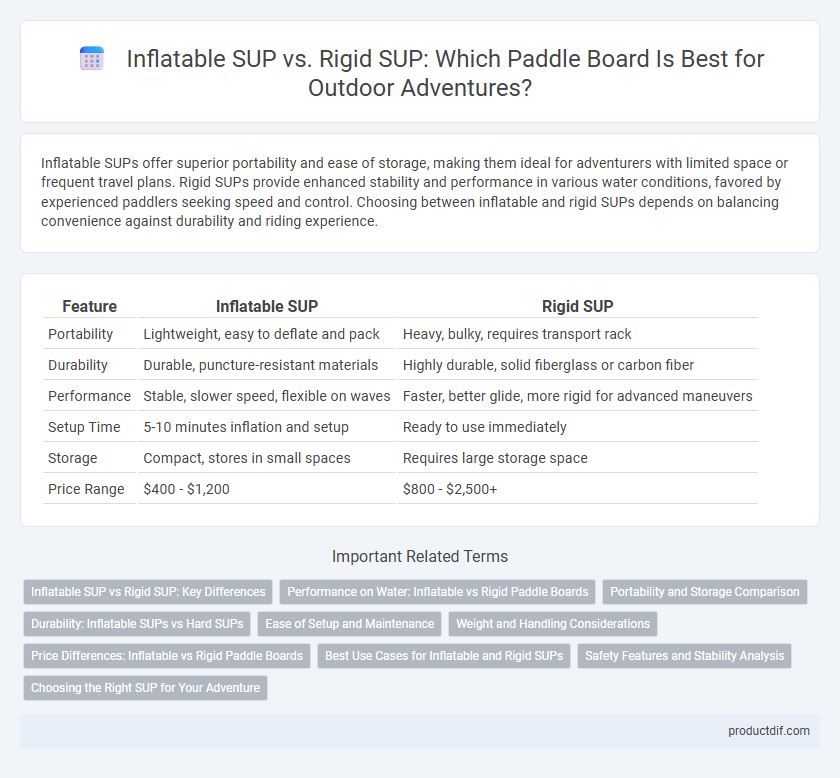Inflatable SUPs offer superior portability and ease of storage, making them ideal for adventurers with limited space or frequent travel plans. Rigid SUPs provide enhanced stability and performance in various water conditions, favored by experienced paddlers seeking speed and control. Choosing between inflatable and rigid SUPs depends on balancing convenience against durability and riding experience.
Table of Comparison
| Feature | Inflatable SUP | Rigid SUP |
|---|---|---|
| Portability | Lightweight, easy to deflate and pack | Heavy, bulky, requires transport rack |
| Durability | Durable, puncture-resistant materials | Highly durable, solid fiberglass or carbon fiber |
| Performance | Stable, slower speed, flexible on waves | Faster, better glide, more rigid for advanced maneuvers |
| Setup Time | 5-10 minutes inflation and setup | Ready to use immediately |
| Storage | Compact, stores in small spaces | Requires large storage space |
| Price Range | $400 - $1,200 | $800 - $2,500+ |
Inflatable SUP vs Rigid SUP: Key Differences
Inflatable SUPs feature lightweight, portable designs with high-grade drop-stitch construction, making them easy to transport and store compared to rigid SUPs made from solid fiberglass or epoxy. Inflatable models typically offer greater stability due to their wider body and increased volume, while rigid SUPs provide superior performance with enhanced rigidity and faster glide on the water. Durability varies as rigid boards resist punctures and abrasions better, whereas inflatable boards can be repaired quickly if punctured, offering versatility for diverse paddling conditions.
Performance on Water: Inflatable vs Rigid Paddle Boards
Rigid SUPs provide superior stability, tracking, and speed on water thanks to their solid construction and streamlined design. Inflatable SUPs offer enhanced portability and are more forgiving on choppy conditions but typically sacrifice some rigidity, which can affect overall performance. For advanced paddlers seeking optimal efficiency and responsiveness, rigid boards remain the preferred choice, whereas inflatable options are ideal for casual use and easy transport.
Portability and Storage Comparison
Inflatable SUPs offer exceptional portability, easily deflating to fit into compact backpacks ideal for travel and storage in small spaces, unlike rigid SUPs which require large racks or storage areas due to their fixed, bulky dimensions. The lightweight nature of inflatable boards enhances convenience for hiking, biking, or car travel, making them preferred for users with limited storage capacity or frequent transport needs. Rigid SUPs provide superior performance in stability and speed but demand more commitment to space and transportation infrastructure.
Durability: Inflatable SUPs vs Hard SUPs
Rigid SUPs typically offer superior durability due to their solid construction using materials like fiberglass, epoxy, and carbon fiber, making them resistant to dings and scratches. Inflatable SUPs, made from military-grade PVC and drop-stitch technology, provide impressive durability through flexibility, allowing them to absorb impacts without permanent damage. Despite their differing materials, both types are designed to withstand environmental stress, but rigid boards generally have a longer lifespan under heavy use conditions.
Ease of Setup and Maintenance
Inflatable SUPs offer superior ease of setup, requiring just minutes to inflate using a hand or electric pump, making them ideal for quick trips and remote locations. Rigid SUPs demand more time and effort to transport and store but provide a hassle-free experience on water without the need for inflation or deflation. Maintenance for inflatable models includes regular valve checks and cleaning to prevent leaks, while rigid SUPs require occasional repairs for dings and scratches to maintain their durability.
Weight and Handling Considerations
Inflatable SUPs typically weigh between 15 to 25 pounds, making them easier to carry and maneuver compared to rigid SUPs, which can weigh 25 to 35 pounds or more. The lightweight nature of inflatable SUPs enhances portability and allows for effortless handling during transport and storage. Rigid SUPs offer better stability and performance on the water but require more effort to lift and control off the water due to their heavier build.
Price Differences: Inflatable vs Rigid Paddle Boards
Inflatable SUPs generally cost between $400 and $900, making them a more budget-friendly option compared to rigid paddle boards, which typically range from $800 to over $1,500. The lower price of inflatable SUPs is due to materials like PVC and drop-stitch construction, while rigid boards use epoxy or fiberglass, increasing production costs. Buyers seeking affordability and portability often prefer inflatables, whereas rigid boards appeal to those prioritizing performance and durability despite the higher price.
Best Use Cases for Inflatable and Rigid SUPs
Inflatable SUPs excel in portability and storage, making them ideal for travelers and casual paddlers who frequent varied water conditions like lakes, rivers, and mild coastal areas. Rigid SUPs offer superior performance, stability, and speed, suited for experienced paddlers, racing, surfing, and long-distance touring on open water. Choosing between inflatable and rigid SUPs depends on usage priorities such as convenience, durability, and specific water sport requirements.
Safety Features and Stability Analysis
Inflatable SUPs offer enhanced safety features with their flexible, shock-absorbent materials that reduce injury risk during falls, while their wider, softer decks improve overall stability for beginners and casual paddlers. Rigid SUPs provide superior tracking and speed but may compromise safety due to harder surfaces and less forgiving impacts, requiring more advanced balance and control skills. Stability analysis indicates inflatable SUPs excel in diverse water conditions by absorbing waves and providing better flotation, making them ideal for recreational use and calm waters.
Choosing the Right SUP for Your Adventure
Inflatable SUPs offer unmatched portability and easy storage, making them ideal for travelers and those with limited space, while rigid SUPs provide superior stability and performance for advanced paddlers seeking speed and precision. Consider factors such as weight capacity, water conditions, and transportation options when selecting the right SUP for your adventure. Prioritizing durability and adaptability ensures a more enjoyable and tailored paddling experience.
Inflatable SUP vs Rigid SUP Infographic

 productdif.com
productdif.com